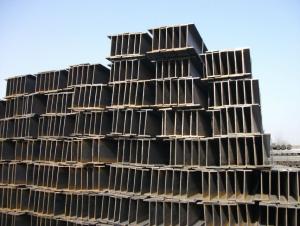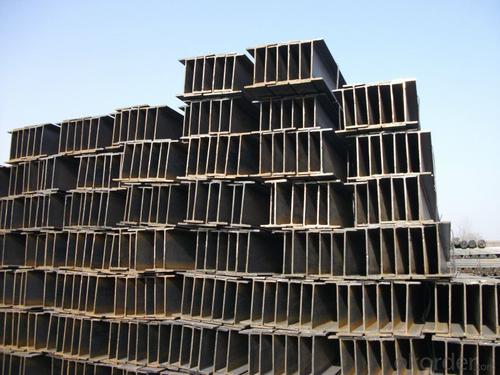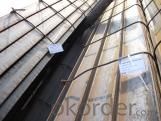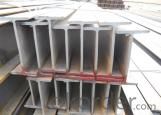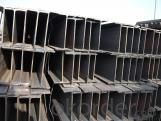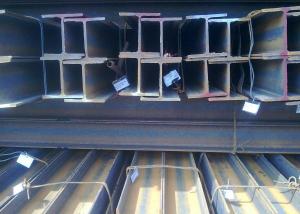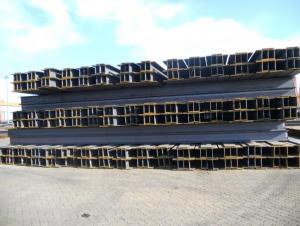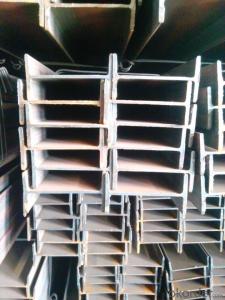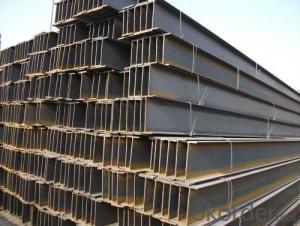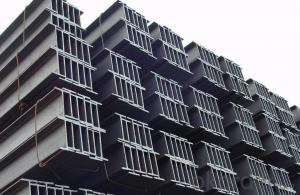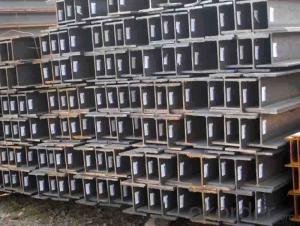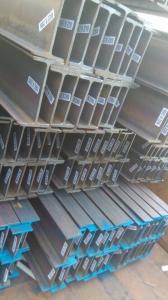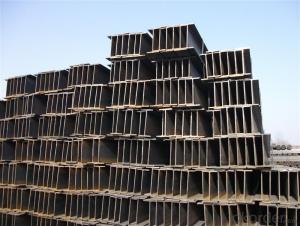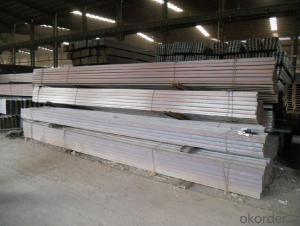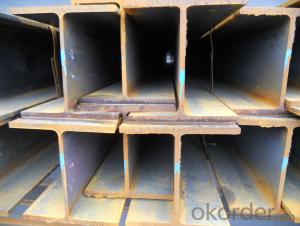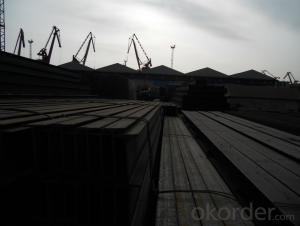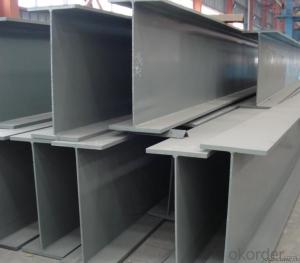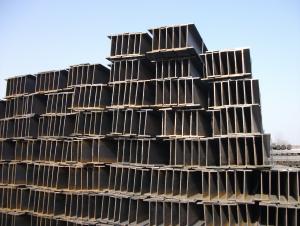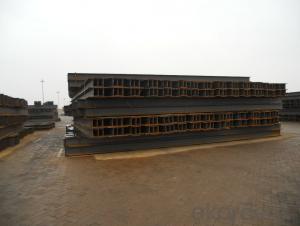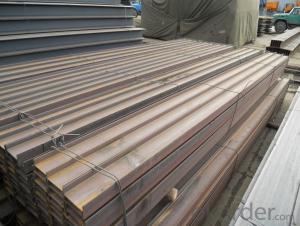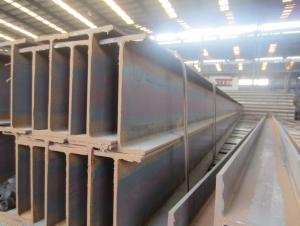SS400 Hot Rolled Structural Steel H Beam
- Loading Port:
- Tianjin
- Payment Terms:
- TT or LC
- Min Order Qty:
- 25 m.t.
- Supply Capability:
- 100000 m.t./month
OKorder Service Pledge
OKorder Financial Service
You Might Also Like
Product Description:
OKorder is offering SS400 Hot Rolled Structural Steel H Beam at great prices with worldwide shipping. Our supplier is a world-class manufacturer of steel, with our products utilized the world over. OKorder annually supplies products to European, North American and Asian markets. We provide quotations within 24 hours of receiving an inquiry and guarantee competitive prices.
Product Applications:
SS400 Hot Rolled Structural Steel H Beam are ideal for structural applications and are widely used in the construction of buildings and bridges, and the manufacturing, petrochemical, and transportation industries.
Product Advantages:
OKorder's SS400 Hot Rolled Structural Steel H Beam are durable, strong, and resist corrosion.
Main Product Features:
· Premium quality
· Prompt delivery & seaworthy packing (30 days after receiving deposit)
· Corrosion resistance
· Can be recycled and reused
· Mill test certification
· Professional Service
· Competitive pricing
Product Description:
Specifications of SS400 Hot Rolled Structural Steel H Beam
1. Standard: GB700-88, Q235B2.
2. Grade: Q235, SS400 or Equivalent
3. Length: 6m,10m, 12m as following table
4. Invoicing on theoretical weight or actual weight as customer request
5.Payment: TT or L/C
6. Sizes:
SIZE(mm) | DIMENSION(kg/m) |
100*100 | 16.9 |
125*125 | 23.6 |
150*75 | 14 |
150*150 | 31.1 |
148*100 | 20.7 |
198*99 | 17.8 |
200*100 | 20.9 |
248*124 | 25.1 |
250*125 | 29 |
Usage & Applications of Hot Rolled Structural Steel H Beam
Commercial building structure ;Pre-engineered buildings; Machinery support structure; Prefabricated structure; Medium scale bridges; Ship-building structure. etc.
Packaging & Delivery of Hot Rolled Structural Steel H Beam
1. Packing: it is nude packed in bundles by steel wire rod
2. Bundle weight: not more than 3.5MT for bulk vessel; less than 3 MT for container load
3. Marks:
Color marking: There will be color marking on both end of the bundle for the cargo delivered by bulk vessel. That makes it easily to distinguish at the destination port.
Tag mark: there will be tag mark tied up on the bundles. The information usually including supplier logo and name, product name, made in China, shipping marks and other information request by the customer.
If loading by container the marking is not needed, but we will prepare it as customer request.
4. Transportation: the goods are delivered by truck from mill to loading port, the maximum quantity can be loaded is around 40MTs by each truck. If the order quantity cannot reach the full truck loaded, the transportation cost per ton will be little higher than full load.
5. Delivered by container or bulk vessel
Production flow of Hot Rolled Structural Steel H Beam
Material prepare (billet) —heat up—rough rolling—precision rolling—cooling—packing—storage and transportation
FAQ:
Q1: Why buy Materials & Equipment from OKorder.com?
A1: All products offered byOKorder.com are carefully selected from China's most reliable manufacturing enterprises. Through its ISO certifications, OKorder.com adheres to the highest standards and a commitment to supply chain safety and customer satisfaction.
Q2: Can fit in the containers of 20fts the steel beams of 6M?
A2: No proble, we can put them into the containers in the form sideling.
Q3: The products are invoicing on theoritical weight or on actual weight?
A3: We can do it in both manners, according to the customers' request.
Images:
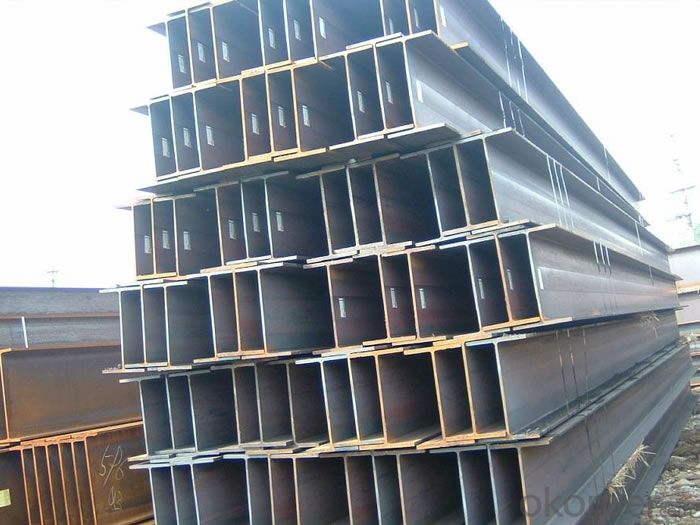
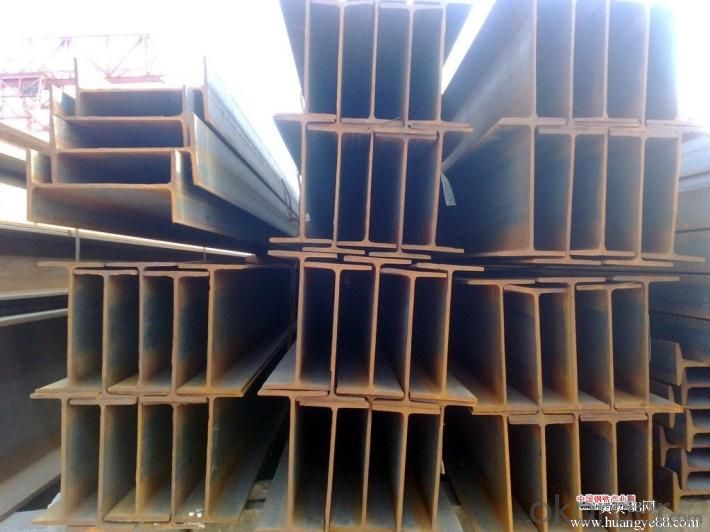
- Q: Can steel H-beams be used in the construction of shopping malls?
- Certainly, shopping malls can utilize steel H-beams for construction purposes. Due to their robustness and endurance, steel H-beams are frequently employed within the construction sector. They deliver crucial support to structures and are commonly employed in the erection of extensive edifices, such as shopping malls. Being capable of enduring substantial weights and offering stability, steel H-beams prove to be an excellent option for constructing the framework of shopping malls. Furthermore, steel is an environmentally friendly and cost-efficient material, making it highly favored in commercial construction ventures.
- Q: Are steel H-beams suitable for supporting nuclear power plant facilities?
- Indeed, nuclear power plant facilities can be effectively supported by steel H-beams. These H-beams are widely used in construction owing to their remarkable strength and ability to bear heavy loads. They offer exceptional structural support and stability, making them an ideal choice for the substantial equipment and structures present in nuclear power plants. Furthermore, steel H-beams possess exceptional resistance to fire, corrosion, and seismic activities, which are vital characteristics for a facility engaged in such delicate operations. Moreover, steel H-beams can be tailored to meet specific design requirements and can be easily adjusted or substituted if necessary. All in all, steel H-beams guarantee reliability and durability when it comes to supporting nuclear power plant facilities.
- Q: Are steel H-beams resistant to electromagnetic interference?
- Steel H-beams are generally not resistant to electromagnetic interference. As steel is a good conductor of electricity, it can easily conduct and transmit electromagnetic waves, making it susceptible to interference. To minimize the impact of electromagnetic interference, additional measures such as shielding, grounding, or using non-conductive materials may be required.
- Q: How do Steel H-Beams contribute to the overall natural ventilation of a structure?
- Steel H-Beams do not directly contribute to the natural ventilation of a structure. Their primary function is to provide structural support and distribute the load of the building. However, the design and construction of a structure using steel H-Beams can allow for the incorporation of ventilation systems such as windows, vents, and openings, which can enhance natural airflow and ventilation within the building.
- Q: Can Steel H-Beams be used in sports or recreational facilities?
- Absolutely, sports or recreational facilities can definitely make use of Steel H-Beams. Due to their robustness, endurance, and load-bearing capabilities, H-Beams are widely employed in the construction industry. In sports or recreational facilities, where expansive areas and lofty ceilings are often required, H-Beams can offer the essential structural support for the edifice. They prove particularly valuable in gymnasiums, indoor stadiums, or arenas, where they can serve as a foundation for the roof, facilitating large clear spans without the need for columns or other hindrances. Moreover, H-Beams can be utilized to establish mezzanine levels for spectators or to create additional space for recreational activities. The versatility and strength of H-Beams render them an ideal choice for crafting secure and functional spaces in sports or recreational facilities.
- Q: What are the different welding methods for steel H-beams?
- There are several different welding methods that can be used for steel H-beams. 1. Shielded Metal Arc Welding (SMAW): Also known as stick welding, SMAW is a common method used for welding H-beams. It involves using a consumable electrode coated in flux, which creates a shield around the weld pool to protect it from contaminants and oxidation. This method is versatile and can be used for welding in various positions and environments. 2. Gas Metal Arc Welding (GMAW): Also known as MIG welding, GMAW uses a continuous solid wire electrode and a shielding gas. This method offers high deposition rates, good weld quality, and can be easily automated. It is commonly used for H-beam welding in fabrication shops. 3. Flux-Cored Arc Welding (FCAW): FCAW is similar to GMAW but uses a tubular electrode filled with flux instead of a solid wire. The flux provides shielding and also contains deoxidizers and other elements to enhance the weld quality. FCAW is known for its high deposition rates and can be used for both indoor and outdoor welding applications. 4. Submerged Arc Welding (SAW): SAW is a highly efficient method that involves feeding a continuous wire electrode into a weld joint while a granular flux is poured over it. The flux covers the weld and prevents atmospheric contamination. SAW is commonly used for heavy-duty applications, such as welding large steel H-beams. 5. Laser Beam Welding (LBW): LBW is a precise and high-energy welding method that uses a focused laser beam to create a weld. It is commonly used for thin steel H-beams and offers excellent control and minimal distortion. However, LBW requires specialized equipment and is typically used in industrial settings. These are just a few of the many welding methods available for steel H-beams. The choice of method depends on factors such as the thickness of the material, desired weld quality, production speed, and available equipment. It is important to select the appropriate welding method based on the specific requirements of the H-beam project.
- Q: Are steel H-beams suitable for structures with irregular shapes?
- Steel H-beams are commonly used in buildings and bridges for their strength and versatility, but their suitability for structures with irregular shapes depends on design requirements and constraints. In general, steel H-beams are a suitable choice for structures with irregular shapes due to their high structural integrity and load-bearing capacity. They can be used to create complex frameworks and support systems that can accommodate various shapes and configurations. Steel's flexibility allows for customization and adaptation to different architectural designs. However, designing and constructing structures with irregular shapes requires careful planning and engineering. The irregular shape may necessitate additional support or reinforcement to ensure structural stability. This can be achieved by combining H-beams with other structural elements, such as braces or trusses, to effectively distribute the load. To assess the suitability of steel H-beams for a specific irregular-shaped structure, it is important to consult professional engineers and architects specialized in structural design. Their expertise can provide valuable insights and calculations to ensure that the H-beams are appropriately sized and positioned to meet the structural requirements and maintain the overall structure's safety. In conclusion, steel H-beams can be suitable for structures with irregular shapes, but their application requires careful consideration of specific design constraints and the expertise of professionals in the field of structural engineering.
- Q: What are the common methods of joining steel H-beams?
- The common methods of joining steel H-beams include welding, bolting, and riveting.
- Q: What are the safety considerations for steel H-beams in construction?
- When utilizing steel H-beams in construction, it is essential to bear in mind several significant safety considerations. First and foremost, it is imperative to guarantee that the steel H-beams being employed meet all requisite quality and safety standards. These beams should originate from reputable suppliers and possess certifications confirming their compliance with the necessary strength and load-bearing capacity requirements. It is vital to comprehend the particular load demands of the construction project and ascertain that the H-beams are designed to withstand the anticipated loads. During the installation process, it is necessary to adhere to proper lifting and handling techniques to avert accidents and injuries. Given that steel H-beams are frequently heavy, specialized equipment is required for their transportation and installation. It is crucial to utilize cranes or forklifts with suitable lifting capacities and securely fasten the beams during transport to prevent any shifting or falling. Additionally, when employing steel H-beams, it is important to ensure appropriate connections and fastenings. The connections between the beams and other structural elements, such as columns or walls, should be designed and executed in accordance with engineering specifications. The use of suitable bolts, welding techniques, or other fastening methods should be employed to guarantee secure attachment of the beams and their ability to withstand the intended loads and forces. Regular inspections and maintenance are also critical for ensuring the ongoing safety of steel H-beams in construction. Periodic inspections should be carried out to inspect for signs of corrosion, damage, or wear. Any issues identified should be promptly addressed to prevent further deterioration and ensure the beams' structural integrity. Finally, providing proper safety measures for workers engaged in the construction process is of utmost importance. This includes furnishing personal protective equipment (PPE) such as hard hats, safety harnesses, and gloves, as well as implementing safety protocols and training programs. Appropriate signage and barricades should be utilized to clearly mark hazardous areas and prevent unauthorized access. By taking these safety considerations into account, construction projects can ensure the secure and efficient utilization of steel H-beams, thereby minimizing the risks of accidents, injuries, and structural failures.
- Q: How do steel H-beams perform in areas with high heat or thermal expansion?
- Steel H-beams are known for their strength and durability, but their performance in areas with high heat or thermal expansion can be affected. Heat causes materials to expand, and steel is no exception. When exposed to high temperatures, H-beams can experience thermal expansion, which can lead to potential issues such as distortion, bending, or even failure. The extent to which H-beams are affected by high heat or thermal expansion depends on several factors, including the temperature, duration of exposure, and the specific type of steel used. Generally, as the temperature increases, so does the expansion of the steel beams. However, different types of steel have varying coefficients of thermal expansion, meaning some may expand more than others under the same conditions. To mitigate the effects of thermal expansion, engineers and architects can take several measures. One common approach is to incorporate expansion joints into the design. These joints allow the steel beams to expand and contract freely without causing damage or distortion to the overall structure. Expansion joints can be strategically placed at intervals along the beams to accommodate the expected expansion and prevent the buildup of excessive stress. Another method is to use steel alloys that are specifically designed to withstand high temperatures and have lower coefficients of thermal expansion. These alloys, such as stainless steel or certain types of heat-resistant steels, are better suited for areas with high heat or thermal expansion. They can better handle the expansion and contraction without compromising the structural integrity. Furthermore, proper insulation and ventilation systems can help regulate the temperature within a building or structure, reducing the risk of extreme heat exposure to the H-beams. Adequate insulation can minimize heat transfer, while effective ventilation can dissipate excess heat and maintain a more stable environment. In conclusion, steel H-beams can be affected by high heat or thermal expansion, potentially leading to distortion or failure. However, through careful design considerations, such as incorporating expansion joints and using appropriate steel alloys, along with proper insulation and ventilation systems, the performance of steel H-beams in areas with high heat or thermal expansion can be improved and their structural integrity can be preserved.
Send your message to us
SS400 Hot Rolled Structural Steel H Beam
- Loading Port:
- Tianjin
- Payment Terms:
- TT or LC
- Min Order Qty:
- 25 m.t.
- Supply Capability:
- 100000 m.t./month
OKorder Service Pledge
OKorder Financial Service
Similar products
Hot products
Hot Searches
Related keywords
